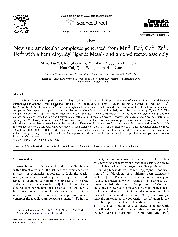摘要
Assemblies of an angular dipyridyl ligand 2,5-bis(4-pyridyl)-1,3.4-oxadiazole (4-bpo) with a series of metal perchlorate afford five new supramolecular complexes with the general formula of [M(4-bpo)(2)(H2O)(4)] center dot (4-bpo)(2) center dot (anion) center dot (solvent), in which M = Mn-II for 1, Fe-II for 2, Co-II for 3, Zn-II for 4, and Fe-III for 5. Although similar molecular structures and compositions are found for these mononuclear complexes, they display two types of supramolecular lattices. Complexes 1, 4 and 5 similarly crystallize in space group P2/n or P2/c. The complex cations, free 4-bpo and lattice water are linked to generate 2D layered frameworks with the aid of hydrogen bonding, and the counter anions are located within and between (also methanol in 5) these 2D arrays. However, complexes 2 and 3 are isostructural in space group P (1) over bar. Two types of alternate 2D layers consisting of complex cations and free 4-bpo components, respectively, are observed with the anions and lattice water locating between them. These motifs are interlinked by complicated hydrogen-bonding to form a 3D intercalated network. Moreover, when Co(NO3)(2) is used instead of CO(ClO4)(2) in the assembly of 3, a 1D polymeric chain complex {[Co(4-bpo)(H2O)(2)(NO3)(2)](H2O)(3)}(n) (6) is generated. These results indicate that the choice of metal ion and anion exerts a significant influence on governing the target complexes. A comparison of the structural features for all metal perchlorate complexes with 4-bpo is also briefly discussed.
- 出版日期2007-4-20
- 单位天津师范大学
